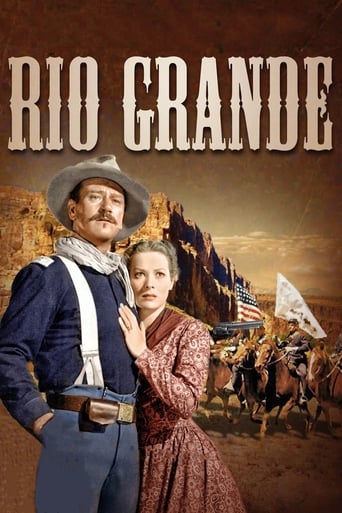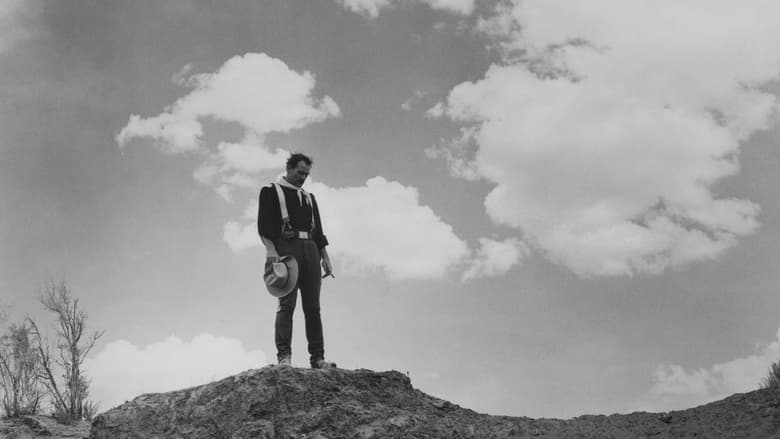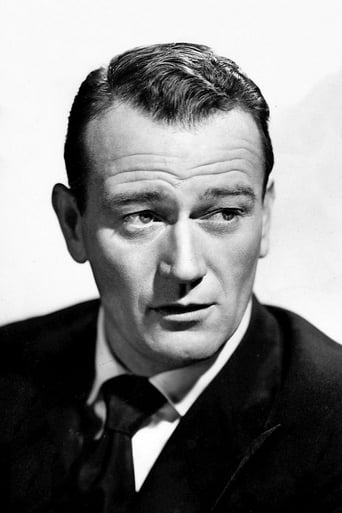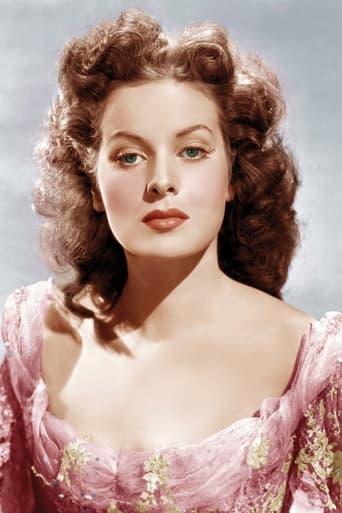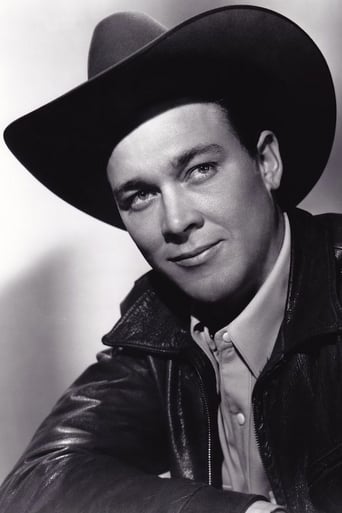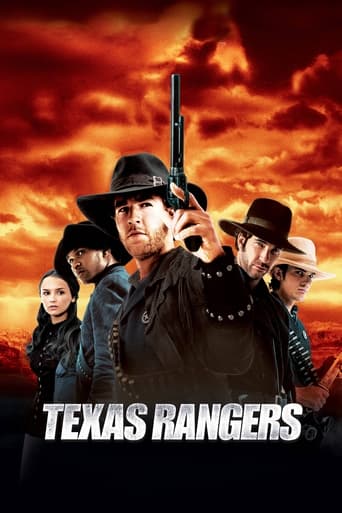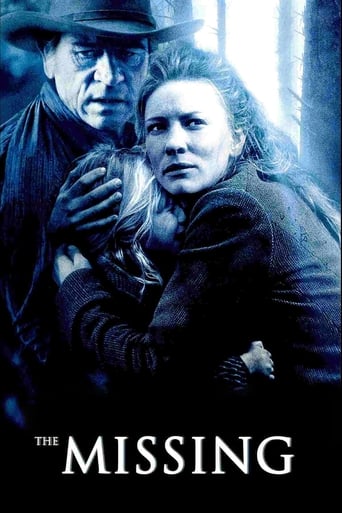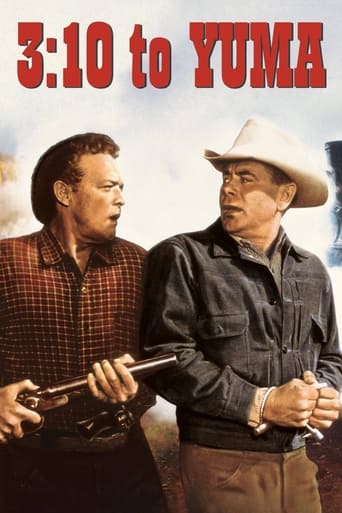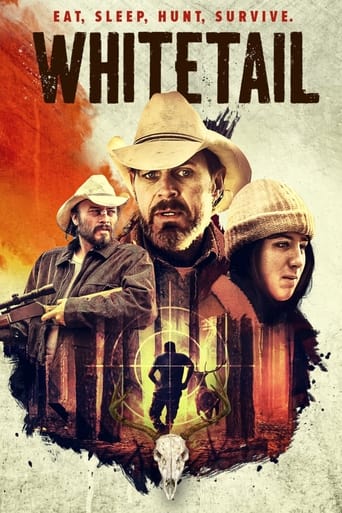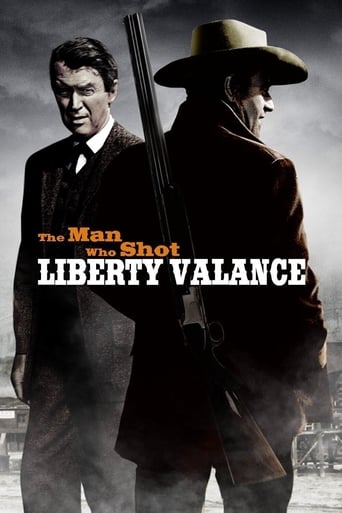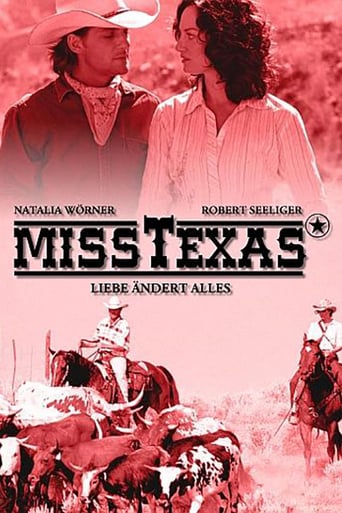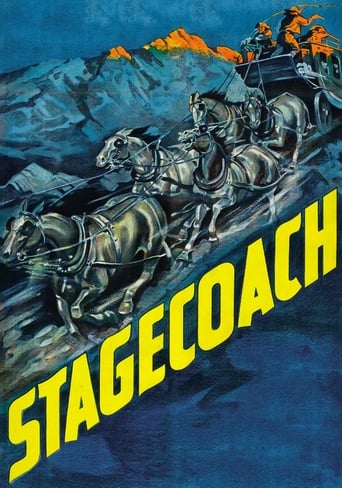Rio Grande (1950)
Lt. Col. Kirby Yorke is posted on the Texas frontier to defend settlers against depredations of marauding Apaches. Col. Yorke is under considerable stress by a serious shortage of troops of his command. Tension is added when Yorke's son (whom he hasn't seen in fifteen years), Trooper Jeff Yorke, is one of 18 recruits sent to the regiment.
Watch Trailer
Cast


Similar titles
Reviews
Just perfect...
From my favorite movies..
I like movies that are aware of what they are selling... without [any] greater aspirations than to make people laugh and that's it.
This is one of the few movies I've ever seen where the whole audience broke into spontaneous, loud applause a third of the way in.
Commanding a remote outpost in Texas, cavalry officer John Wayne reconnects with estranged wife Maureen O'Hara and new-recruit son Claude Jarman Jr. However, the reunion is complicated by an Apache uprising and an illegal incursion across the Rio Grande.One of the lesser talked-about pairings of Wayne and John Ford and their third cavalry picture, this is satisfying, though a bit familiar in the drama department. Action scenes and Monument Valley locations are excellent, as are the musical numbers by Ken Curtis and the Sons Of The Pioneers. O'Hara looks a little young to have a teenage son though.Memorable subplots include fugitive recruit Ben Johnson trying to stay ahead of the law and some male-bonding between himself, Jarman, and fellow soldiers Harry Carey Jr. and Victor Maglaglen.
The great thing about "Rio Grande" is how it engages you as a story of lives in motion, filling the screen with great spectacle and private heartbreak, sometimes simultaneously. It's a fine primer on the rugged beauty that is a John Ford film.It also too often showcases the other, lesser side of Ford, the maudlin showman prone to sacrificing subtlety for blarney and shortchanging action scenes for exercises in rote choreography and drill routines. Fortunately for Ford and us, he also had his greatest weapon, John Wayne, in prime condition to deliver the sort of performance that leaves all else behind in heavenly clouds of dust.Wayne is Col. Kirby Yorke, tough commander of a cavalry unit stationed in Fort Starke, a Texas posting that lives up to its name. He gives us the facts of the matter early on, to a group of recruits that include his own son, Jeff (Claude Jarman, Jr.):"I don't want you men fooled about what's coming up for you. Torture. At least that." Col. Yorke adds he will tie any man who fails him to a wagon wheel and bust to bits anyone who tries to desert.But Col. Yorke's not ornery like some other Wayne characters, just tough and fair. We register early on that he's proud of Jeff even as the boy stands up to him, in one of several scenes nicely played by Jarman. The colonel's overriding sense of duty was once tested when he burned down a plantation belonging to his Confederate wife, Kathleen (Maureen O'Hara). Fifteen years, two months, and seven days later she still hasn't forgiven him, but the desire still burns, and sears when she appears at Fort Starke to try and bring her son home. Watching these two interact on-screen for the first time is a study in how less can be more, with all the words unsaid between them fluttering across their limpid eyes.This is really what "Rio Grande" is about, though Ford was obligated to bring in a Western and did so with some business about marauding Apaches who need to be quelled. The situation is complicated by the fact the Apaches have based themselves across the title river in Mexico, and rooting them out may trigger a political crisis.This could have been a fine storyline in itself, but Ford's lack of interest in it is too obvious. He puts the Apaches on the back- burner for a half-hour, then throws up an out-of-nowhere attack on Fort Starke which liberates some prisoners Col. Yorke helpfully left by an underguarded fence-line. For the rest of the film, intermittent battle scenes present either Apaches or troopers riding heedless into rifle fire with no apparent strategy other than outdoing one other for best horse fall. I never get Ford's reputation as a great action director; he was always better directing around it.The film suffers a bit from too much singing, like other commenters here point out, but the performance of one song, "I'll Take You Home Kathleen" justifies Ford's predilection. Here we get another clinic in zen acting from Herself and the Duke, as they make the shyest of eye contact, him unnerved, her touched by the song with its implications of romance interrupted. You know throughout the scene that Yorke is thisclose from telling the singers to buzz off, but he doesn't because, you know, he really feels it, too."This music was not of my choosing," he croaks at the end."I'm sorry, Kirby," she answers, just as tightly. "I wish it had been."Moments like that, of which there are many in this movie, make me too grateful to begrudge Ford the occasional excess or line, like Kathleen's too on-the-nose remark to her husband: "I'm sorry your sense of duty made you destroy two beautiful things, Bridesdale and us." It's a beautifully composed film, even at times to a fault, and at its best, which it frequently is, "Rio Grande" gives us a chance to watch Wayne play off his favorite leading lady in fascinating style. A beautiful film which feels perfect, even if it isn't.
The last of director Ford's cavalry trilogy, all starring or costarring John Wayne, and including Victor McLaglen as the cut up sergeant major, usually leading the comic relief, balancing Wayne's serious roles. Also, all involved hostile or potentially hostile Native Americans(N.A.)of the southern plains or Southwest. In this film, as well as the previous "Fort Apache", the Apache were the featured threatening N.A., whereas in "She Wore a Yellow Ribbon", it was a confederation of other southern plains tribes. Wayne's character, who had been given a different name in the latter film, regains his name: Kirby York(modified to Yorke)from "Fort Apache" , suggesting that the present film might be considered a sequel to that film, in which Yorke pays back the Apache for their thrashing of the cavalry in the earlier film....I suspect this was Ford's last B&W film, he generally favoring B&W over color through his long previous career. "She Wore a Yellow Ribbon" was filmed in Technicolor, finally giving his audiences a colorful view of some of his favorite scenic landscapes in the Southwest.Ford's agreement with Republic Pictures was that they would finance this cheapie, which hopefully would turn a fair profit, in exchange for financing Ford's long denied pet project, which would become known as "The Quiet Man": to be filmed in Technicolor and on location in Ireland, as Ford demanded. Republic wrongly predicted a loss on that film. Republic also stipulated that Wayne and popular Maureen O'Hara, along with Victor McLaglen, would star in both films. Thus, instead of a 'young love' aspect to the script, as in the 2 previous films, Maureen(as Kathleen) was cast as the estranged wife of Colonel Kirby, whose marriage had been blown apart by the Civil War, which pitted Yankee officer Kirby against her Shenandoah family, he and Stg. Quincannon(McLaglen) having been ordered by General Sheridan to torch the family plantation. She has traveled far to this western outpost to retrieve her son Jeff who, by chance, was recently assigned to his father's outfit as a new recruit, and refuses to leave nor to use his family status as a springboard for special treatment.The foray of the cavalry across the Rio Grande, into Mexico, is based upon a historical incident, in which renowned 'Indian' fighter Ranald McKenzie was diverted by his commander Phil Sheridan from his campaign against the Comanche to destroy the villages of marauding N.A.s using Mexico as a sanctuary. The film accurately portrays Sheridan as giving this as an unofficial order, to avoid an international incident if it turned out badly. Actually, the N.A.s were mostly Kickapoo, with some Lipan and Mescalero Apache and other tribes represented. Interestingly, the stampeding of the horses of the threatening confederation of southern plains tribes in "She Wore a Yellow Ribbon" can be considered a loose representation of McKenzie's final victory over the remaining renegade Comanche and allies, with minimal loss of life on both sides. It's apparent that the new recruits(only 18 instead of the 180 promised) tend to form friendship groups based on their former identities as Union or Confederate soldiers or sympathizers. Thus, Kirbe's son Jeff(a Virginian, played by Claude Jarman) soon forms a friendship group with Texans 'Sandy'(Harry Carey, Jr.) and Travis Tyree(Ben Johnson). Carey and Johnson had fairly high profile roles in "She wore a Yellow Ribbon" and were a buddy pair in Ford's other western released in '50; "Wagon Master", as they are in this film. Carey was nicknamed 'Sandy' in both '50 films. Johnson was Travis in both '50 films, but retained his last name from "She wore a Yellow Ribbon" as did McLaglen. Those who have seen "The Yearling" will easily recognize Claude(Jeff) as Jody. Chill Wills, also in that film, plays the fort doctor here.Like "Wagon Master" and unlike the 2 previous cavalry westerns, this film was shot in Eastern Utah, without significant additional use of Monument Valley backdrops. Presumably, the Colorado River substituted for the Rio Grande.Although the previous films of the trilogy included occasional songs sung by the cavalry or featured at social gatherings, music supplied by the Sons of the Pioneers, included among the troopers, positively permeates this film, and often relates to the hoped for rekindled relationship between Kirby and Kathleen. It begins appropriately with "I'll Take You home , Kathleen", initially heard from a music box she brought, soon elaborated on by troopers as she dines with Kirby. During the finale, to Kirby's surprise, the parading troopers sing "Dixie". Maureen guiltily smiles, and General Sheridan nods his approval, as most of the troopers being honored for their part in shooting up the Apaches and rescuing the stolen children are southerners.In a running gag, Travis is periodically nearly taken away by a marshal on a murder charge, but is deemed too valuable a trooper to lose, and always escapes, with or without Kirby's approval.I don't understand why they had the raiding Apaches living around a Mexican mission rather than in a typical Apache village, nor why the Apaches attacked the poorly constructed fort in broad daylight(risk of high mortality). Historically, there was a reservation Seminole village(not the presumed Apaches shown)close to Fort Clark, which supplied scouts for the raid across the Rio Grande from this fort.
It is so sad that the younger crowd avoids back and white movies just because ..... well, because they're black and white. They're depriving themselves of a lot.I put Rio Grande on my Netflix queue because I stumbled on the title somewhere and realized that it was one of the Ford/Wayne westerns I had not seen. I had seen Fort Apache and She Wore a Yellow Ribbon. I had liked the former only moderately, and didn't care much for the latter. My favorite Ford western was My Darling Clementine. Rio Grande blew me away from the beginning. A previous commenter mentioned the photography. In the Netflix version I saw it is absolutely gorgeous - the best B&W cinematography I think I've ever seen (after Clementine). The acting is wonderful, with all the usual John Ford crew on hand. Great to see Wayne and Maureen O'Hara working together again. For me it's a tough call between Rio Grande and Clementine as to which better captures the majestic sweep of the western landscape. The story line is a venerable one - mother/father conflict over a struggling son, with mother overprotective and father being tough.This is must-see for fans of westerns and especially for devotees of Ford, Wayne, and O'Hara.

